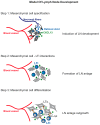Mesenchymal cell differentiation during lymph node organogenesis
- PMID: 23248630
- PMCID: PMC3522075
- DOI: 10.3389/fimmu.2012.00381
Mesenchymal cell differentiation during lymph node organogenesis
Abstract
Secondary lymphoid tissues such as lymph nodes are essential for the interactions between antigen presenting cells and lymphocytes that result in adaptive immune responses that protect the host against invading pathogens. The specialized architecture of these organs facilitates the cognate interactions between antigen-loaded dendritic cells and lymphocytes expressing their specific receptor as well as B-T cell interactions that are at the core of long lasting adaptive immune responses. Lymph nodes develop during embryogenesis as a result of a series of cross-talk interactions between a hematopoietically derived cell lineage called lymphoid tissue inducer cells and stromal cells of mesenchymal origin to form the anlagen of these organs. This review will present an overview of the different signaling pathways and maturation steps that mesenchymal cells undergo during the process of lymph node formation such as cell specification, priming, and maturation to become lymphoid tissue stromal organizer cells.
Keywords: NF-κB; lympho-mesenchymal interactions; lymphoid tissues; lymphotoxin beta receptor; stromal cells.
Figures

References
-
- Ansel K. M., Ngo V. N., Hyman P. L., Luther S. A., Forster R., Sedgwick J. D., et al. (2000). A chemokine-driven positive feedback loop organizes lymphoid follicles. Nature 406 309–314 - PubMed
-
- Brendolan A., Rosado M. M., Carsetti R., Selleri L., Dear T. N. (2007). Development and function of the mammalian spleen. Bioessays 29 166–177 - PubMed
Grants and funding
LinkOut - more resources
Full Text Sources

